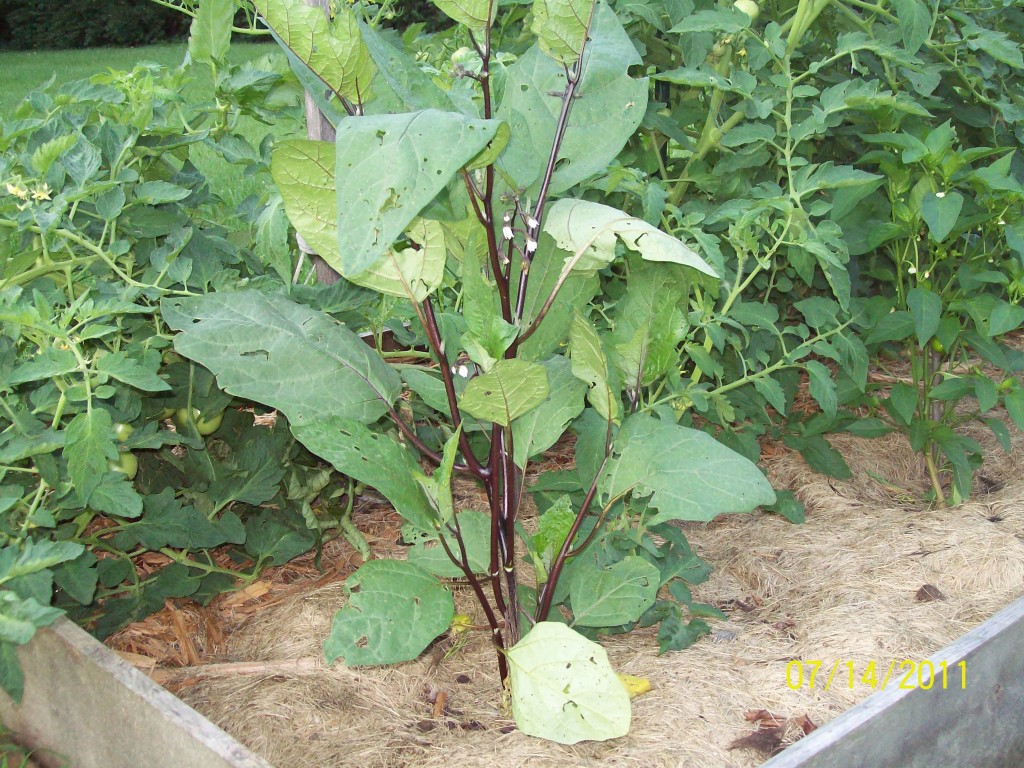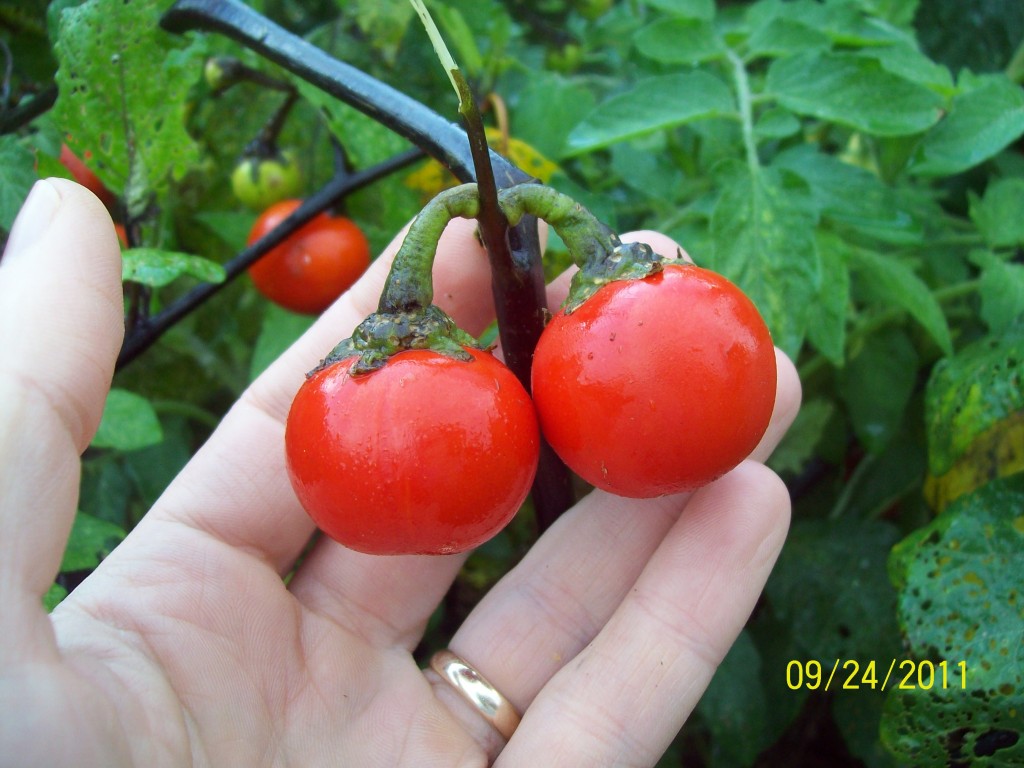The case of the Gilo Black Stem
By BOB McKinley
I’m a restless gardener, and a bit of a dilettante in the vegetable patch. I get bored growing the same things year after year, and with the exception of some tried and true heirlooms like Sara Black tomatoes, I’m always looking for something exotic to shake things up. So in the cold and gloom of deep winter, when the gardening itch is just starting to stir from its hibernation, I scour the seed catalogs for vegetable inspiration. My wife calls it Garden Porn. I’ve found heirloom treasures that originate from all over the world. Belarus, Sri Lanka, Korea, Russia, India, and a host of vegetables from right here in the good old USA.
Last winter a seed saving acquaintance from Pennsylvania contacted me about a rare African eggplant she had come across. Being aware of my propensity for the unusual, she wanted to give me first crack at the seeds. The eggplant was called Gilo Black Stem and purportedly originated from Uganda. She described it as tasting similar to cooked carrots. An eggplant that tastes like carrots? Sign me up.
In the gloom of March
In the deep and abiding gloom of March, I planted my little African pals in their cell trays, hooked up the grow lights and waited with much impatience. By the time spring and warmth had arrived my Gilo was about 3 inches tall and I couldn’t wait to put them in the ground. But eggplant demands warm weather (just a few days of temps in the 50s can stunt the plant, retard fruit production, or even kill it) and with our inherently fickle climate I had to restrain myself until June. By this time the plants were six inches tall and had already begun to distinguish themselves from the other Sri Lankan and Asian eggplants I had started.
Living up to its name, the stem of the Gilo had indeed begun to turn a distinctive shade of very dark brown, if not quite black. The stem also seemed to be thicker and denser than the other ones I was growing. The leaf structure was nearly identical, but the color of the foliage was a bit more yellowish.
And, even better, the small plants seemed to be slightly resistant to the bane of all eggplant: the Flea Beetle.
A quick aside about Flea Beetle management
Flea beetles will flock to an eggplant and immediately begin devouring it, so even a tiny bit of added vigor in this department goes a long way. The best trick I’ve ever picked up came from John Walker, a founding member of Faith Feeds. If you’ve been engaged in the Lexington gardening community at all, you probably know John. If you’re growing vegetables and you don’t know John, you need to. He hosts the Edible Garden Series, an invaluable learning resource for novice and expert gardeners alike. (Find out more about John through the Faith Feeds Facebook page.)
John discovered that if you raise the tiny eggplants high off the ground during their formative stage, you can fend off the flea beetle until they are ready to be transplanted into the ground. This pest free window is crucial to getting the eggplant off to a good start. Undamaged plants take root and grow faster than ones that have been ravenously chewed up by pests.
John made a makeshift shelf for his plants that beats using pesticides any day. He simply used five gallon buckets and boards. The theory is that a flea beetle can only jump so high, so get it high enough so the little pests can’t reach it. From observation, between 3 and 5 feet seems like a good range for the height. (Once your tender eggplant is in the ground, use Food-Grade Diatamaceous Earth to control pests. It’s effective, completely free of chemicals, and will not hurt animals if they get into it.)
Back to the story at hand
In June, I put four Gilo Black Stem eggplants in a single raised bed at the Crossing Church off of Todds Road. In-Feed uses this bed for vegetables we want to grow in isolation so we can save pure seed. Ninety-five percent of what I grow is Heirloom and therefore open-pollinated. You cannot put two or more of the same variety of vegetable in one location without the risk of cross pollination. If you save seed, you don’t want your Sweet Italian Frying Pepper turned into a volcanic tongue burner by his neighbor the Habanero.
Alongside the Gilo, I put in four Belarus Orange tomato plants to help shade the smaller eggplants from our typically brutal afternoon sun. Along with peppers, eggplant are often well served by the shade from taller plants or man-made sunbreaks.
After a month of watering, fending off flea beatles and providing an abundance of care, the Gilo Black Stem was already three feet tall and the branches were producing tiny purple flowers. The plant has a growth habit similar to Okra, with the main stem and branches tending to shoot more or less straight up, giving the whole mass of the plant a tall and skinny profile. At this point the five foot tall plants required staking. The stems are very sturdy and resistant to breaking in the face of high winds and storms, but they will fall over given enough of a push by Mother Nature.
Another month of watering, watering and even more watering in the midst of an unrelenting hot and dry spell saw the budding of tiny yellow fruit. The little round eggplant started off pale yellow and about two inches wide. More flowers were coming on every day, and it looked like there would be a bumber crop of Gilo. I couldn’t wait to taste this carrot doppelgänger on my plate.
In early August I had my first handful of the mature red eggplant. They looked very much like blood red cherry tomatoes, and almost every person I showed them off to, made the same erroneous guess. Now all I needed to do was chow down.
Bitter fruit and a global eggplant hunt
Quite frankly, they were so bitter it was like trying to eat aspirin. Eggplant can have a tendency to be naturally bitter… but there is bitter and then there is EVIL. So, I went back to my seed source who confessed she had never prepared the eggplant herself and had merely assumed the description she had been given from her source to be accurate. Some ethnic cuisine calls for bitterness, so I set out to determine if the bad flavor problem was a result of my poor culinary skills—or a lack of some key spice or special ingredient.
The first place I went was the African-Caribbean Market in Eastland Shopping Center. The folks there were fantastic, but unfortunately they had never seen my eggplant before. They were convinced I had a cherry tomato, until I peeled back the skin to reveal the white mass inside. They set out, with much enthusiasm, to contact some customers they knew from Uganda and the neighboring regions. Turns out there is a Gilo grown in that area of Africa, but it is much larger, is egg shaped, and starts off green (which is its edible stage) before turning red.
There was one valuable clue gleaned from their detective work. Gilo was taken from Africa during colonization and through the slave trade became a popular vegetable in Brazil. Aha. I must have some Brazilian relative of the original Gilo on my hands.
So, being the old geezer that I am, I reluctantly made use of that new-fangled internet machine to research Brazilian Gilo. Lacking basic internet search skills, it took me awhile to find out that the eggplant is spelled with a J in Brazil. Alas, the Brazilian Jilo was exactly like the one the proprietors at African-Caribbean Market had described to me. And just like that I was back to square one. Further scouring of the internet revealed no pertinent information.
At this point, I brought some of the Gilo to a Faith Feeds meeting and showed it off. Mary Powell, a board member, was excited to see the little red mystery fruit. It seems she had seen the plant in one of her catalogs. Mary is quite the eclectic gardener in her own right and has grown or aspired to grow a lot of things off the traditional gardeners list. She was confident that it was an Asian variety, but could not remember any further details.
Armed with this new lead, I headed straight to Yu Yu Asian Supermarket. I was then very firmly informed by several staff and customers that I obviously had a cherry tomato. Despite my protests to the contrary, they were adamant I had a tomato in my hands. So, once again, I tore open the Gilo and revealed the white mass inside, upon which several people smelled the opened fruit, dissaproved, and shrugged their shoulders at me.
I proceeded on, with a growing sense of resignation, to Hibarri Market, Seoul Supermarket, Sagar India Market and too many ethnic restaurants to count. I was rewarded each time with the same look of “stupid man, that’s a tomato.” And just to prove I’m not as dumb as I look, I made an effort at each stop to rend open the Gilo and vindicate myself. Looking at an empty gas tank, a crate full of mystery eggplant, and my frustrated visage in the rearview mirror, I headed home in defeat.
EG 168
A few days later, Mary Powell emailed me the bad news. She had found my Gilo in Baker Creek Seeds Online catalog. It was listed under the name EG 168. And to my dismay, it was an ornamental variety. Apparently, it is dried, then used in Japanese flower arrangements as an accent. Not deadly if you ingest it, but certainly not a vegetable you will have any luck making palatable—much less cooking in any conceivable manner that would wring the flavor of cooked carrots out of it.
But there is always hope for the new garden when every spring rolls around. I have a brand new pack of “Grandma Nellie’s Mushroom Bean” ready to go, and you guessed it, it’s supposed to taste like mushrooms. Hope springs eternal, but I’ll believe it when I eat it.






lisa b
Will love to hear how the Mushroom Beans taste 🙂 I enjoyed your quest to find the eggplant name